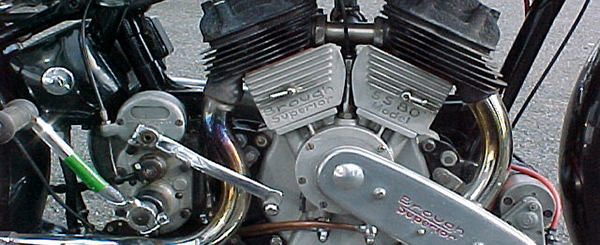 United Kingdom – A furious Welsh motorcycling colleague of mine has just telephoned me to say that thieves had stolen 4 rare motorcycles from his almost unique collection of 12 and carried them away would you believe in his recently restored classic Bedford van.
United Kingdom – A furious Welsh motorcycling colleague of mine has just telephoned me to say that thieves had stolen 4 rare motorcycles from his almost unique collection of 12 and carried them away would you believe in his recently restored classic Bedford van.
It would appear they had simply lifted them through the roof of his garage using a JCB that had itself been stolen locally a few hours earlier.
What he was really upset about was that some of his friends had spotted his bikes in pieces at a classic bike event some one hundred miles away and were according to their report “absolutely definitely his bits”.
When the Hedlu’s (Welsh police) arrived on the scene however they were not convinced.
The fact that the seller, an ‘Autojumbler’ was according to the police ‘a decent chap’ and had proved to them that he had purchased the items himself in good faith a few weeks earlier at another event.
Unfortunately there were no identification numbers or features on any of the parts that would allow the officers to support the allegation that they could be stolen and I wonder just how many of us have heard that before?
Whilst we rely on the law to assist us at times like these, we now have to more than ever provide the means for that to happen.
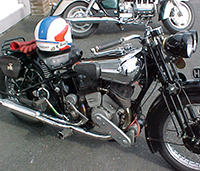 There is an old stated case which is still effective that stipulates that ‘you cannot pass title to anything that you do not own’ which literally means that if I steal from you it doesn’t matter how many people that subsequently acquire that same property, it’s still yours!
There is an old stated case which is still effective that stipulates that ‘you cannot pass title to anything that you do not own’ which literally means that if I steal from you it doesn’t matter how many people that subsequently acquire that same property, it’s still yours!
Be warned however to recover it you now have to prove that property was definitely and beyond doubt yours in the first place. A crime report merely indicates that you have reported an incident such as theft or burglary and it can simply contain as much or as little information as you can supply to the police.
Suggestions that you may believe are reasonable in identification to establish your ownership such as “It’s obviously mine” or “there can’t be more than half a dozen in the world” and perhaps “I had it repainted to my specification” may no longer be good enough to reclaim it and certainly not enough to support a theft or dishonest handling charge against its ‘new owner’.
That said your personal adaptations, alterations, welding or damage may be sufficient, providing there are enough of them together to establish ‘without any doubt’ that it’s your property.
There is after all a point whereby the court has to err on the fact that evidence of a dozen or more unique coincidences together may construe sufficient proof.
Suffice to say that nowadays after theft, if you’re happy with the insurance money, that’s fine, but if you really want your vehicle returned to you then you should mark it and make it unquestionably yours.
A man in Derbyshire admitted recently when stopped by police that he had stolen the bike that he was riding and he had also erased all of the identification numbers on it.
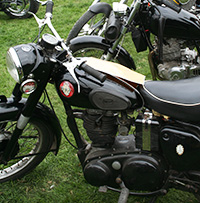 He also admitted that he had fitted another number plate to the bike which applied to the identity of another machine.
He also admitted that he had fitted another number plate to the bike which applied to the identity of another machine.
Enough you might think to receive some punishment but no!
The police had failed to find exactly what stolen motorcycle it was because it’s real identity had been removed and therefore they could not find it’s original owner at the time of theft to prove it had been stolen.
The judge not only ordered the bike be returned to the prisoner but he ruled that the prisoner could sue the police for depriving him of its use. To rub salt in the wound the judge also denied the police any right to appeal.
Another recent criminal case revolved around an engineer that repaired and overhauled electrical components, such as magnetos, dynamos and starter motors etc for mainly classic vehicles.
He was good at what he did but business went in decline when customers complained of poor workmanship.
Fortunately like many of his counterparts, the engineer marked all of his repaired components with his initials.
Unbeknown to him, his ‘in house’ apprentice had also set up his own parallel business substituting the engineers own properly repaired parts for his own.
The engineers’ dissatisfied clients were being given the faulty parts by the apprentice and it wasn’t long before they complained. The apprentice then engaged his ‘new’ clients offering good workmanship originally undertaken by the engineer.
In court the apprentice was convicted, the sentence being trivial but the Judge explained in summing up that without the evidence of identification, the jury would most certainly have failed either to understand the evidence or convict, nor could any of the property be reclaimed and more important perhaps the engineers reputation might not have been restored.
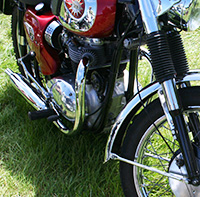 Yet another case revolves around a collection of stolen classic and vintage bikes, stolen over a period of 11 years and stored until it was felt safe to export them. In fact their assumed equity value had eventually been exchanged to honour the thief’s debt.
Yet another case revolves around a collection of stolen classic and vintage bikes, stolen over a period of 11 years and stored until it was felt safe to export them. In fact their assumed equity value had eventually been exchanged to honour the thief’s debt.
Some of these machines were not registered for the road in the UK when stolen and others had just one identification digit changed. Should any vigilant official involved in the export process have bothered to check a database then they might have discovered their true provenance (which they didn’t!).
Having reached their first destination the stolen machines outside Paris in France they were seen in a storage barn near by no less a person than a friend of one of the owners of a one of the stolen bikes.
The local police at that time whilst friendly were not able to assist without documentation to support the crime allegation. In the UK the police were having difficulty finding the 9 year old theft report and when they did find them no identification numbers had been recorded.
The major problem was effectively the seizure or halting of any future movement of these suspected stolen machines until ownership could be established.
Evidence from old crime reports, all reported on different dates in different years by various officers had to be obtained and from owners many of whom had long since moved on and could not be contacted
Would the owners want their machinery back or not and more importantly would or could they identify their own machines after all this time?
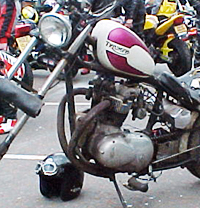 Fortunately two of these uninsured ‘pristine’ machines, ironically both with previous theft history, had enough marks on them to establish a link with their owners who quickly produced statements of theft. Indeed a simple ‘I love you daddy’ note had been left in the handle bar of one of the bikes by the owners daughter (now 17 but then 8 years old) to establish a rather unique but positive identification.
Fortunately two of these uninsured ‘pristine’ machines, ironically both with previous theft history, had enough marks on them to establish a link with their owners who quickly produced statements of theft. Indeed a simple ‘I love you daddy’ note had been left in the handle bar of one of the bikes by the owners daughter (now 17 but then 8 years old) to establish a rather unique but positive identification.
A magistrates warrant enabled the Gendarmerie to seize all of the bikes whilst enquiries continued.
No one was arrested or charged and 7 of the machines were eventually identified and returned to their owners. Four of these owners had been paid out by their insurance companies but still had the machines returned to them. After all just because a bike is stolen from you and you are paid out for the loss by the insurance company, it does not necessarily mean you cant’ have it back.
The ownership of another four bikes which could not be identified as stolen was not contested by anyone. They were according to French custom auctioned and sold, current whereabouts unknown.
The movement of machinery around the world is a growing problem for the authorities. It doesn’t appear to be the case for the organised criminal gangs who continue to exploit the export and import loopholes by using either erased or stolen identities to move classic vehicles thousands of miles away from the place of theft.
It’s pretty tough as you might imagine for all those who are trying to prevent events like these from happening.
There has been no doubt however that micro dots, almost invisible to the naked eye and no larger than this → • ← have not only made the question of identification and ownership a lot easier and much more risky for the thief.
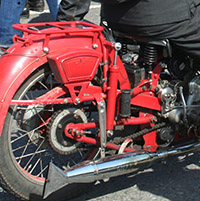 The European Union council have been researching and deliberating on WOVM (Whole of Vehicle Marking) for some time and already next year WOFM will be implemented in several countries throughout the world.
The European Union council have been researching and deliberating on WOVM (Whole of Vehicle Marking) for some time and already next year WOFM will be implemented in several countries throughout the world.
Technology however dose not stand still and new ways of establishing provenance have been developed.
Identification DNA, not the real Deoxyrybonucleic acid that living organisms have but a recently developed and unique liquid, invisible to the naked eye, that can be painted onto or injected into any type of object, has been created and now offered by several companies.
We can only hope that our possessions one day will all be marked indelibly allowing them to be identified for what they really are and who owns them.
Quite simply if property can always be identified, then the question of ownership is established and the work of the police becomes easier; surely this should deter most thieves and reduce theft.
Dr Ken German


Three things are required to ID any item:
1. Clear, visible ID marks which are difficult to remove and will be an effective deterrent.
2. Covert ID such as Smartwater, Microdts or Radio Frequency IDentification (RFID Microchips). Of these only RFID microchips manuafctured to ISO 11784/5 FDXB are nabck by legislation.
3. Registration on a database for the police, Trading Standards and loss adjusters.
There are a few but only the National Mobile Property Register (www.thenmpr.com) has Home Office approval under the Data Proptection Act and it is FREE for life.
Take a look at our web site and see the video
It’s still out there http://www.smartwater.com
And then there is http://www.selectadna.co.uk
what happened to smartwater? had it on on my Honda Fireblade – brilliant stuff, just painted it on and was unqiue to my machine.